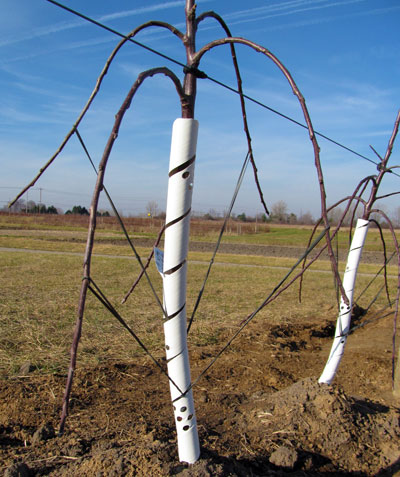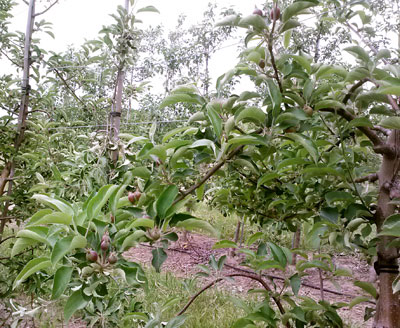Training apples for high density systems
The window of opportunity to train apples growing in high density systems is approaching. This management tool influences flower bud initiation and can make a difference in developing a productive orchard.
We are approaching a critical period for training apples growing in high density systems which influences flower bud initiation. This a management tool that is critical in the first four years of the life of a young orchard and can a make a difference in developing a productive orchard or one that challenges the boundaries of excessive vigor and low cropping.
What is flower bud initiation?
In apples, the period known as flower bud initiation begins about mid-June and continues through mid-July in the northern United States. Initiation is defined as the formation of flower parts within buds or the change from a vegetative to a reproductive bud. Frequently, the early portion of this stage is determined “induction” and the latter portion “development.” This also means that flowers for next year’s crop are being formed some seven to nine months in advance of bloom, or “anthesis.” So, while growers are intent on managing the crop for the current year, they are also affecting the crop for next year. See the Michigan State University Extension article “Enhance return bloom on apple varieties by using summer NAA” for more information.
What affects is flower bud initiation?
In apples, the factors that are most critical during this period are light penetration into the canopy, current crop load, nutrition, water, temperature, rootstocks/vigor and branch angle, or “gravity.” So if the tree or branches are stressed caused by excessive shade, drought stress, nutritional deficiencies or excessive crop load (on many varieties but not all, such as Gala) during this period, you can see a negative effect on flower bud initiation towards more vegetation and less reproduction; vigorous rootstocks can do this, as well. Knowing this, growers can influence flower bud initiation to their advantage by deploying practices that help encourage the potential for more flowers and fruit.
Branch angles
We have known for quite some time from various research studies that upright branches have a tendency to be more vigorous and less reproductive. Branches bent to horizontal or sub-horizontal angles will slow in growth rate that promotes flower bud initiation. This is commonly seen in branches with a large crop.
I can remember visiting Jeff DeCoster in the mid-1980s in Belgium who was promoting multi-row and Super Slender Spindle orchards by weighting down branches between June 22 (longest day of the year) and about mid-July using cement weighted hooks, weighted clothes pins, cotton string and rubber bands. I can even remember growers gluing nails formed in hook pattern to rocks for this practice. I began using the blue UVI-resistant rubber bands in those years with good success. The advantage of using bands is that over time, the bands disintegrate and avoid branch girdling. The practice is labor intensive and typically can’t be done to all branches. However, being able to bend at least five to six branches that are exposed to light for each tree can induce more fruiting that, in turn, competes with vegetative growth and over all makes the tree more reproductive and less vigorous.
The practice of bending branches can and should begin immediately after planting (Photo 1). If “feathers,” or 1- to 3-feet long branches formed in the nursery, come with trees, bend them down to horizontal for Vertical Axe or down to below horizontal for Tall Spindle. This practice is more critical at closer spacing such as 3 feet for Tall Spindle.

Photo 1. Bending branches in recently planted Tall Spindleapple trees. Rubber bands are used here (looped twotogether for added length).
For woody branches, I recommend the use of floral wire (18 inches) at 20 to 24 gauge (Photo 2). The floral wire can be moved at the beginning of the following season up into the canopy.

Photo 2. Using floral wire (20 gauge) to bend woody branches.
Rubber bands and floral wire are useful for new vegetative growth accomplished between mid-June and mid-July (Photo 3). Wait until growth is at least 10 to 12 inches long before bending to avoid breakage with pressure in bending. Be careful with young branches as the rubber band elasticity can change with temperature and amount of stress. I have gone back the next day and found many young branches broken overnight, so don’t overdo it!
Caution: The period for flower bud initiation in apples in the northern United States may coincide with fire blight activity. For more on when to train branches during this infection period, see "Training apples for high density and avoiding the spread of fire blight."

Photo 3. Using UV light-resistant rubber bands to bendyoung branches.
While this seems labor intensive, it will reduce pruning time and labor during winter, slow branch growth down, encourage more spurs and more flowering. In turn, the canopy is more compact and increased cropping slows down vegetative growth which is important in developing trees with good balance between fruit development and vegetative growth (Photo 4).

Photo 4. Impact of bending branches accomplished inprevious years.



 Print
Print Email
Email

